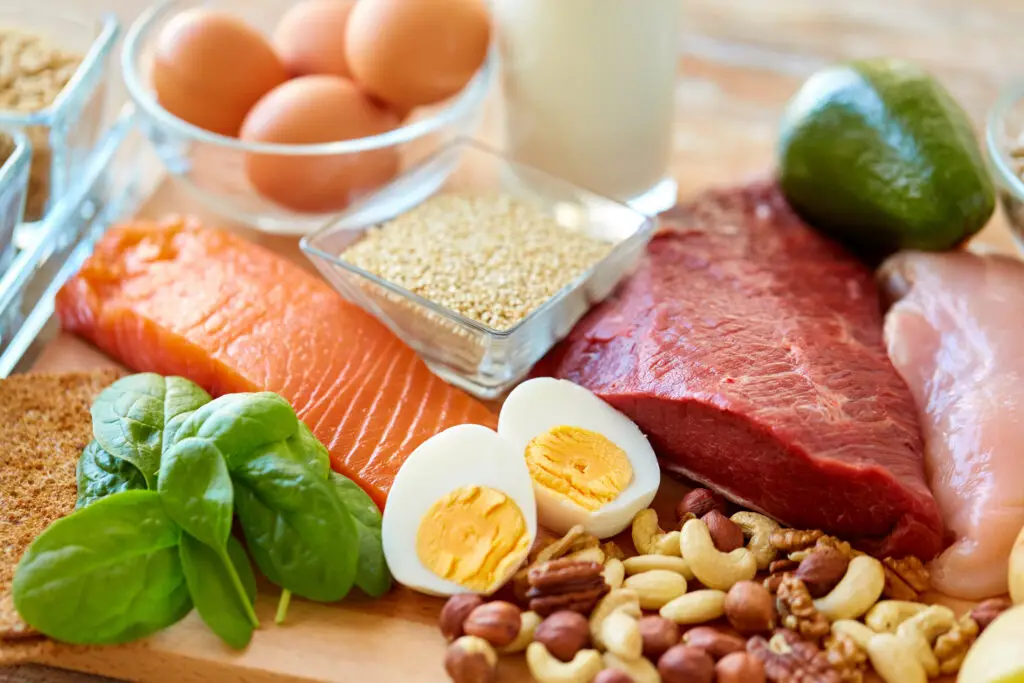When Jeremy first walked into my gym, he was carrying 20kg more than he wanted and feeling frustrated with his previous attempts at getting fit. At 25 years old, he’d tried various diets and exercise programmes, but nothing had delivered the results he was after. What made Jeremy’s case particularly interesting was his goal: he didn’t just want to lose weight – he wanted to completely transform his body composition by losing 20kg of fat whilst simultaneously gaining 12kg of lean muscle mass.
This ambitious goal would require a complete understanding of protein requirements for muscle building, something I’ve spent over a decade researching and applying with hundreds of clients. The confusion around protein intake is one of the biggest obstacles I see people face when trying to build muscle. Some clients come to me eating barely any protein, whilst others are consuming expensive supplements they don’t need, often based on outdated or misleading information.
Jeremy’s transformation became a perfect case study for demonstrating how evidence-based protein strategies can deliver remarkable results. Over 18 months, we achieved exactly what we set out to do – he lost 20kg of body weight whilst gaining 12kg of lean muscle mass, completely transforming not just his appearance but his strength, energy levels, and confidence.
In this article, I’ll share the science-backed protein strategies that made Jeremy’s transformation possible. I’ll cut through the myths and marketing claims to give you the real facts about protein requirements for muscle building. Whether you’re looking to build muscle, lose fat, or achieve both simultaneously, as Jeremy did, understanding your protein needs is absolutely crucial for success.
The protein requirements for muscle building aren’t as straightforward as many people think. Your needs depend on your training status, age, goals, and even the timing of your protein intake throughout the day. By the end of this article, you’ll have a clear understanding of exactly how much protein you need, when to consume it, and how to meet your requirements through both food and supplements when necessary.

The Science of Protein and Muscle Building
Understanding Muscle Protein Synthesis
To understand why Jeremy’s transformation required such careful attention to protein intake, we need to start with the fundamental process of muscle protein synthesis (MPS). This is the biological process by which your body builds new muscle proteins, and it’s the foundation of all muscle growth.
Every day, your muscles are in a constant state of breakdown and rebuilding. Muscle protein breakdown (MPB) occurs naturally as part of normal cellular turnover, whilst muscle protein synthesis works to replace and add to the existing muscle proteins. The balance between these two processes determines whether you gain, lose, or maintain your muscle mass.
When Jeremy started training with me, his muscle protein synthesis was likely elevated due to the novel stimulus of resistance training, but without adequate protein intake, his body couldn’t take full advantage of this increased capacity for muscle building. This is where many people go wrong – they focus entirely on the training stimulus whilst neglecting the nutritional foundation that makes muscle growth possible.
Research shows that muscle protein synthesis can remain elevated for up to 48 hours after a resistance training session, but only if adequate amino acids are available in the bloodstream. Without sufficient protein intake, this window of opportunity for muscle growth is largely wasted. This is why I immediately addressed Jeremy’s protein intake as the first priority in his nutrition plan.
The process of muscle protein synthesis requires all essential amino acids to be present in adequate quantities. Think of it like building a house – you need all the necessary materials available at the right time, or construction stops. Leucine, in particular, acts as a key trigger for initiating muscle protein synthesis, which is why the quality and timing of protein intake matter just as much as the total amount.
Protein Balance and Net Protein Accretion
The concept that transformed Jeremy’s understanding of muscle building was protein balance – the relationship between muscle protein synthesis and muscle protein breakdown. For muscle growth to occur, muscle protein synthesis must exceed muscle protein breakdown over time, creating what we call net protein accretion.
During Jeremy’s initial assessment, I explained that his body was likely in a negative or neutral protein balance most of the time. His previous diet contained adequate protein for basic health, but not enough to support the muscle growth he wanted, whilst simultaneously losing fat. This dual goal made his protein requirements even higher than someone focusing solely on muscle building.
When you’re in a caloric deficit to lose fat, as Jeremy needed to be, muscle protein breakdown naturally increases, whilst muscle protein synthesis can be suppressed. This creates a challenging environment for muscle growth, which is why many people struggle to build muscle while losing fat. However, with the right protein strategy, it’s absolutely possible – Jeremy’s results prove this.
The key insight that changed everything for Jeremy was understanding that protein balance isn’t just about daily totals – it fluctuates throughout the day based on when and what you eat. After a protein-rich meal, muscle protein synthesis increases and can exceed breakdown for several hours. Between meals, especially during longer fasting periods, muscle protein breakdown can exceed synthesis.
By strategically timing Jeremy’s protein intake, we were able to keep him in positive protein balance for more hours of each day, maximising his muscle-building potential even whilst in a caloric deficit. This approach required consuming protein every 3-4 hours throughout the day, with particular attention to post-workout and pre-sleep protein intake.

Factors Affecting Protein Requirements
Jeremy’s protein requirements weren’t determined by a simple formula – they were influenced by multiple factors that I had to consider when designing his nutrition plan. Understanding these factors is crucial for anyone serious about optimising their muscle-building results.
Age plays a significant role in protein requirements. At 35, Jeremy was experiencing the early stages of age-related muscle loss, known as sarcopenia, which typically begins around age 30. Older adults require higher protein intakes to achieve the same muscle protein synthesis response as younger individuals, a phenomenon called anabolic resistance.
Training status was another crucial factor. As a relative beginner to serious resistance training, Jeremy initially had a heightened sensitivity to both training and protein intake. However, as he became more trained over the months, his protein requirements actually increased because his body became more efficient at utilising protein for muscle building, requiring higher intakes to maximise this process.
Jeremy’s goal of simultaneous fat loss and muscle gain significantly increased his protein requirements. When in a caloric deficit, protein needs increase for several reasons: higher protein intake helps preserve muscle mass during weight loss, protein has a higher thermic effect than other macronutrients (helping with fat loss), and adequate protein helps maintain training performance despite being in an energy deficit.
Body composition also influenced Jeremy’s protein calculations. Initially carrying excess body fat, we based his protein requirements on his lean body mass rather than total body weight, as fat tissue has minimal protein requirements. As his body composition improved, we adjusted his protein intake accordingly.
The type and intensity of Jeremy’s training programme affected his protein needs as well. His programme focused heavily on compound movements with progressive overload, creating significant muscle damage and requiring higher protein intakes for optimal recovery and adaptation compared to someone doing lighter, less intensive training.
Evidence-Based Protein Recommendations
General Population vs Athletes
When I first met Jeremy, he was following general population protein guidelines of around 0.8 grams per kilogram of body weight per day. At his starting weight of 95kg, this meant he was consuming roughly 76 grams of protein daily – nowhere near enough for his muscle-building goals.
The recommended dietary allowance (RDA) for protein is designed to prevent deficiency in sedentary individuals, not to optimise muscle building in someone undertaking intensive resistance training. This fundamental misunderstanding is why so many people struggle to build muscle despite training consistently.
Research specifically examining resistance-trained individuals shows dramatically different protein requirements. Studies consistently demonstrate that people engaged in regular strength training require 1.6-2.2 grams of protein per kilogram of body weight per day to maximise muscle protein synthesis and muscle growth.
For Jeremy’s goals of simultaneous muscle building and fat loss, I set his protein intake at the higher end of this range – 2.2 grams per kilogram of lean body mass. This meant that as his body composition improved and his lean mass increased, his absolute protein requirements actually increased over time, which many people don’t expect.
The difference between general population recommendations and athlete requirements isn’t just about quantity – it’s about understanding the purpose. General recommendations aim to maintain nitrogen balance and prevent muscle loss. Athletic recommendations aim to maximise muscle protein synthesis, enhance recovery, and support adaptation to training stress.
Jeremy’s transformation required thinking like an athlete, even though he wasn’t competing in any sport. His training intensity, frequency, and goals demanded an athletic approach to nutrition, particularly protein intake. This mindset shift was crucial for his success.
Strength Training Specific Requirements
Jeremy’s resistance training programme created specific protein demands that went beyond general athletic recommendations. The type of muscle damage caused by progressive resistance training requires higher protein intakes than endurance activities or recreational exercise.
Research examining strength-trained individuals shows that protein requirements can be even higher than the general athletic population, particularly during periods of intensive training or when trying to build muscle in a caloric deficit. Studies suggest that strength athletes may benefit from protein intakes of 2.3-3.1 grams per kilogram of lean body weight per day.
For Jeremy, I initially set his protein intake at 2.4 grams per kilogram of lean body weight, which translated to approximately 180 grams of protein per day based on his estimated lean mass of 75kg. This might seem high compared to general recommendations, but it was necessary to support his ambitious goals.
The timing of Jeremy’s strength training sessions also influenced his protein requirements. Training in the evening meant his overnight recovery period was crucial for muscle protein synthesis. This led us to implement a pre-sleep protein strategy, adding an additional 40 grams of casein protein before bed to support overnight muscle building.
As Jeremy’s training progressed and intensified, we actually increased his protein intake further. By month six of his programme, when he was lifting significantly heavier weights and training six days per week, his protein intake reached 2.6 grams per kilogram of lean body weight to support his increased training demands.
The type of strength training Jeremy performed also mattered. His programme emphasised compound movements like squats, deadlifts, and bench presses, which create more overall muscle damage and systemic stress than isolation exercises. This full-body approach to training required higher protein intakes to support recovery across multiple muscle groups simultaneously.

Age-Related Protein Need Adjustments
At 35, Jeremy was at an age where protein requirements begin to increase due to the onset of anabolic resistance. This age-related change in how the body responds to protein intake is something many people aren’t aware of, but it significantly impacts muscle-building success.
Research shows that adults over 30 require approximately 20% more protein than younger adults to achieve the same muscle protein synthesis response. This means that protein recommendations based on studies of college-aged participants may underestimate the needs of older adults, even those in their thirties.
The mechanism behind this age-related increase in protein requirements involves changes in muscle sensitivity to amino acids, particularly leucine. Older adults need higher concentrations of leucine to trigger muscle protein synthesis, which translates to higher overall protein requirements.
For Jeremy, this meant that even if he had been 25 years old with identical goals and training, his protein requirements would have been lower. At 35, I had to account for this age-related anabolic resistance by setting his protein intake at the higher end of the research-supported range.
The quality of protein becomes even more important with age. Jeremy’s protein sources needed to be rich in leucine and other essential amino acids to overcome his slightly reduced sensitivity to protein intake. This influenced our food choices, emphasising complete proteins from animal sources and strategic combinations of plant proteins.
As Jeremy ages, his protein requirements will continue to increase gradually. I’ve educated him about this so he can adjust his intake accordingly in the future. By age 50, he may need 2.8-3.0 grams per kilogram of lean body weight to maintain the same muscle-building response he achieved in his thirties.
Calculating Jeremy's Personal Protein Needs
Body Weight-Based Calculations
Determining Jeremy’s exact protein requirements required careful calculation based on multiple factors. The most common approach is body weight-based calculations, but for someone like Jeremy who needed to lose significant fat whilst building muscle, this method required modification.
At his starting weight of 95kg, a simple calculation of 2.2 grams per kilogram would have suggested 209 grams of protein per day. However, this calculation includes his excess fat mass, which has minimal protein requirements. Fat tissue doesn’t contribute significantly to muscle protein synthesis, so basing calculations on total body weight would have overestimated his needs and made his diet unnecessarily difficult to follow.
Instead, I used Jeremy’s estimated lean body mass for calculations. Through body composition analysis, we determined that his starting lean mass was approximately 75kg. Using 2.4 grams per kilogram of lean mass, his initial protein target was 180 grams per day – significantly more manageable than 209 grams, yet still optimal for his goals.
As Jeremy’s transformation progressed, his lean mass increased whilst his total body weight decreased. By month 12, his lean mass had increased to 82kg, whilst his total weight had dropped to 87kg. This meant his protein requirements actually increased to 197 grams per day (2.4 x 82kg), despite weighing less overall.
This approach of basing calculations on lean mass rather than total weight is particularly important for people with higher body fat percentages or those undergoing body recomposition. It ensures adequate protein for muscle building without unnecessarily high intakes that can make adherence difficult.
The lean mass-based approach also allowed us to adjust Jeremy’s protein intake as his body composition improved, ensuring his nutrition plan evolved with his changing physiology. This dynamic approach to protein calculation was crucial for maintaining optimal muscle protein synthesis throughout his transformation.
Meeting Protein Requirements Through Food
High-Protein Food Sources and Amounts
Teaching Jeremy to meet his protein requirements through whole foods was essential for long-term success. Whilst supplements played a role in his plan, the majority of his protein intake came from carefully selected food sources that provided not only protein but also other nutrients necessary for muscle building and overall health.
Chicken breast became Jeremy’s primary protein source, providing approximately 31 grams of protein per 100 grams with minimal fat and carbohydrates. A typical 200-gram serving provided 62 grams of high-quality protein, making it easy to meet his daily targets. The versatility of chicken breast also made meal preparation more manageable.
Lean beef provided variety whilst delivering excellent protein quality. A 150-gram serving of 95% lean ground beef provided approximately 32 grams of protein along with important nutrients like iron, zinc, and vitamin B12. The higher caloric density of beef meant smaller portions were used compared to chicken, but it added valuable nutritional diversity.
Fish, particularly salmon and tuna, provided high-quality protein along with beneficial omega-3 fatty acids. A 150-gram serving of salmon provided about 31 grams of protein whilst supporting recovery and reducing inflammation from intense training. Jeremy consumed fish 2-3 times per week for both protein and health benefits.
Eggs were particularly valuable for Jeremy’s breakfast meals. Two whole eggs plus four egg whites provided approximately 26 grams of protein with a complete amino acid profile. The combination of whole eggs and egg whites allowed for adequate protein whilst controlling calories and fat intake.
Greek yoghurt served as both a protein source and a convenient snack option. A 200-gram serving of non-fat Greek yoghurt provided about 20 grams of protein along with probiotics for digestive health. This made it ideal for Jeremy’s mid-morning or afternoon snacks.
Cottage cheese became Jeremy’s go-to pre-sleep protein source. A 150-gram serving provided approximately 18 grams of casein protein, perfect for supporting overnight muscle protein synthesis. The slow-digesting nature of casein made cottage cheese ideal for this timing.
Meal Planning for Protein Goals
Jeremy’s meal planning required careful attention to ensure each meal contributed meaningfully to his daily protein targets whilst fitting within his caloric constraints. This systematic approach to meal planning was crucial for maintaining consistency over the 18-month transformation period.
Breakfast typically provided 35-40 grams of protein through combinations like scrambled eggs with Greek yoghurt, or protein pancakes made with whey protein powder and egg whites. Starting the day with adequate protein helped establish positive protein balance early and supported appetite control throughout the morning.
Lunch meals were designed around lean protein sources, typically providing 40-45 grams of protein.
A typical lunch might include 200 grams of chicken breast with vegetables and a small portion of rice, or a large salad with 150 grams of salmon and quinoa. These meals provided substantial protein whilst including other nutrients necessary for recovery and health.
Dinner was often Jeremy’s largest protein meal, providing 45-50 grams of protein. This might include 250 grams of lean beef with vegetables, or 200 grams of fish with sweet potato. The larger protein portion at dinner helped ensure daily targets were met whilst providing satiety for the evening hours.
Snacks were strategically planned to bridge gaps between meals and provide additional protein. Mid-morning snacks typically provided 20-25 grams of protein through options like Greek yoghurt with berries, or a protein smoothie. Afternoon snacks served a similar purpose, often including options like cottage cheese with fruit or a small portion of nuts with a protein shake.
Pre and post-workout nutrition received special attention in Jeremy’s meal planning. Pre-workout snacks provided 15-20 grams of easily digestible protein, whilst post-workout meals provided 35-40 grams of high-quality protein to maximise recovery and muscle protein synthesis.
The key to Jeremy’s meal planning success was preparation and consistency. We developed a rotation of 15-20 different meals that met his protein requirements, then repeated these meals throughout the week. This approach reduced decision fatigue whilst ensuring nutritional targets were consistently met.
Conclusion: Your Protein Action Plan
Jeremy’s transformation demonstrates that with the right protein strategy, remarkable body composition changes are possible. The key insights from his journey can be applied to your own muscle-building goals, regardless of whether you’re trying to lose fat simultaneously or focusing purely on muscle growth.
Your protein requirements are higher than general population recommendations if you’re serious about building muscle. Aim for 1.6-2.2 grams per kilogram of lean body weight daily, with higher intakes needed if you’re in a caloric deficit or over 30 years old.
Protein timing matters as much as total intake. Consume 20-40 grams of protein every 3-4 hours throughout the day, with particular attention to post-workout and pre-sleep protein intake. This approach maintains consistently elevated muscle protein synthesis.
Protein quality significantly impacts results. Prioritise complete proteins with high leucine content, particularly from animal sources. If using plant proteins, ensure adequate leucine intake through larger servings or strategic combinations.
Supplements can be valuable tools when used strategically. Use whey protein post-workout for rapid amino acid availability, casein protein before bed for overnight muscle building, and other supplements to fill gaps in your whole food intake.
Consistency is the key to success. Jeremy’s results came from following his protein strategy consistently for 18 months, not from perfect adherence for short periods. Develop sustainable habits that you can maintain long-term.
Start implementing these strategies today. Calculate your personal protein requirements, plan your meals and timing, choose high-quality protein sources, and use supplements strategically. With the right approach to protein intake, you can achieve the muscle-building results you’re after.
Remember that protein is just one piece of the muscle-building puzzle, but it’s a crucial piece that many people get wrong. Get your protein strategy right, and you’ll be well on your way to achieving the transformation you desire.









